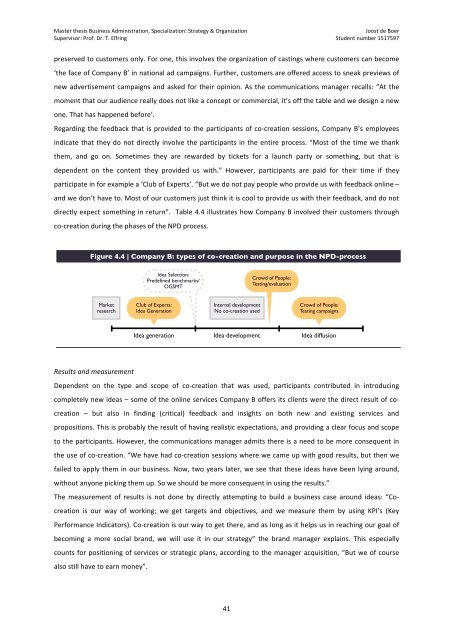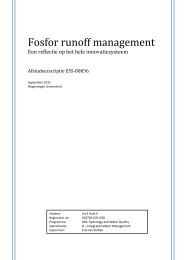Download PDF (English) - Future Ideas
Download PDF (English) - Future Ideas
Download PDF (English) - Future Ideas
You also want an ePaper? Increase the reach of your titles
YUMPU automatically turns print PDFs into web optimized ePapers that Google loves.
Master thesis Business Administration, Specialization: Strategy & Organization <br />
Supervisor: Prof. Dr. T. Elfring <br />
Joost de Boer <br />
Student number 1517597 <br />
preserved to customers only. For one, this involves the organization of castings where customers can become <br />
‘the face of Company B’ in national ad campaigns. Further, customers are offered access to sneak previews of <br />
new advertisement campaigns and asked for their opinion. As the communications manager recalls: “At the <br />
moment that our audience really does not like a concept or commercial, it’s off the table and we design a new <br />
one. That has happened before’. <br />
Regarding the feedback that is provided to the participants of co-‐creation sessions, Company B’s employees <br />
indicate that they do not directly involve the participants in the entire process. “Most of the time we thank <br />
them, and go on. Sometimes they are rewarded by tickets for a launch party or something, but that is <br />
dependent on the content they provided us with.” However, participants are paid for their time if they <br />
participate in for example a ‘Club of Experts’. “But we do not pay people who provide us with feedback online – <br />
and we don’t have to. Most of our customers just think it is cool to provide us with their feedback, and do not <br />
directly expect something in return”. Table 4.4 illustrates how Company B involved their customers through <br />
co-‐creation during the phases of the NPD process. <br />
Figure 4.4 | Company B: types of co-creation and purpose in the NPD-process<br />
Idea Selection:<br />
Predefined benchmarks/<br />
OGSMT<br />
Crowd of People:<br />
Testing/evaluation<br />
Market<br />
research<br />
Club of Experts:<br />
Idea Generation<br />
Internal development<br />
No co-creation used<br />
Crowd of People:<br />
Testing campaigns<br />
Idea generation Idea development Idea diffusion<br />
Results and measurement <br />
Dependent on the type and scope of co-‐creation that was used, participants contributed in introducing <br />
completely new ideas – some of the online services Company B offers its clients were the direct result of co-creation<br />
– but also in finding (critical) feedback and insights on both new and existing services and <br />
propositions. This is probably the result of having realistic expectations, and providing a clear focus and scope <br />
to the participants. However, the communications manager admits there is a need to be more consequent in <br />
the use of co-‐creation. “We have had co-‐creation sessions where we came up with good results, but then we <br />
failed to apply them in our business. Now, two years later, we see that these ideas have been lying around, <br />
without anyone picking them up. So we should be more consequent in using the results.” <br />
The measurement of results is not done by directly attempting to build a business case around ideas: “Co-creation<br />
is our way of working; we get targets and objectives, and we measure them by using KPI’s (Key <br />
Performance Indicators). Co-‐creation is our way to get there, and as long as it helps us in reaching our goal of <br />
becoming a more social brand, we will use it in our strategy” the brand manager explains. This especially <br />
counts for positioning of services or strategic plans, according to the manager acquisition, “But we of course <br />
also still have to earn money”. <br />
41





